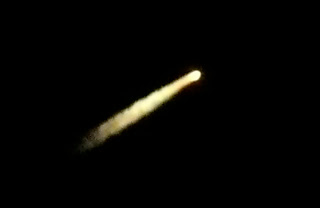My family and I had a long weekend together in Orlando, FL. We came in from all over the place; my parents drove up from Miami, my sister flew in from the Baltimore area, and my wife and I drove down from Pensacola. We made the most out of it, celebrating my parents' anniversary, my mother's birthday, Thanksgiving, and my birthday since they all fall within three weeks of each other.
On Saturday, we took a drive over to Kennedy Space Center. Space Shuttle
Endeavour had launched the night before, so there were no shuttles on the pad. My dad managed to snag a night shot of the launch from afar during their drive up and my sister saw it while she was waiting for us at KMCO. I was about the same distance as they were, inbound from the north, but I was under a solid overcast layer. I'm glad at least some of us got to see it.
I hadn't been to KSC since I was a very small child. As I've mentioned before on this blog, I've always been fascinated with space flight. I try to keep up with the newest developments in space technology, space travel, and launches via the internet, but actually being around the "real deal" was very interesting for me. KSC is simply a fascinating place.
My dad put it best:
what other country has a fully operational space launch facility that is also a tourist attraction? I can't imagine just walking into Russia's Plesetsk Cosmodrome, Kazakhstan's Baikonur Cosmodrome, the European Space Agency's facility in French Guiana, or any of China's multiple launch centers. Not to say that you can just wander anywhere inside KSC, but in any other country you'd need special permission just to be on the premises. I think it's great to be able to see the actual hardware up close and personal, and gives you a feel for how far we've come and where we (and our tax dollars!) are going.
Without further ado, here's the photo tour:
My dad's photo of Endeavour's night launch.
The Vehicle Assembly Building. To get an idea of the scale, the blue area of the American flag is the size of a regulation basketball court.
 The Saturn V moon rocket. Words cannot describe just how immense this machine is.
The Saturn V moon rocket. Words cannot describe just how immense this machine is. 
Volkswagen? BMW? Mercedes? Nope - this is the pinnacle of German engineering, via Werner Von Braun.

Lunar Excursion Module

Third stage of the Saturn V.

Too... big.... Can't... fit... in... picture....
 A recreation of the Apollo 8 Saturn V launch, featuring the original equipment used for the real launch.
A recreation of the Apollo 8 Saturn V launch, featuring the original equipment used for the real launch. One of the launching pads, originally used for the Apollo rockets and currently used for the shuttle. They were still in the process of cleaning it after the launch the night before.
 The world's largest clean room, where they assemble and test the components of the International Space Station.
The world's largest clean room, where they assemble and test the components of the International Space Station.
A mock up of the ISS' cozy little "space john".

Crawler-transporter with the VAB in the background, shrouded by rain.

The rain cometh!
Detail of one of the crawler-transporters.



























